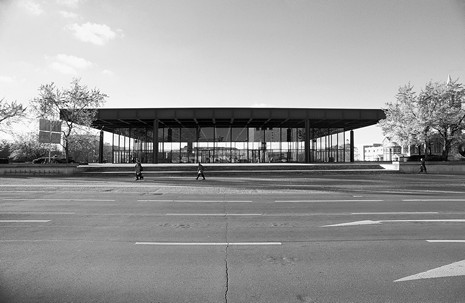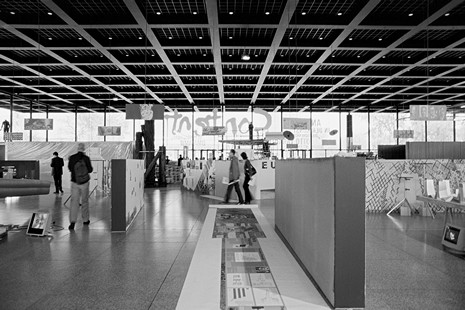Description
The burning desire to have a representative late work by one of the most important architects of the twentieth century was the prime motive for awarding the National Gallery project to Ludwig Mies van der Rohe. Only afterward was the epoch-making spatial enclosure fitted out with paintings from two different collections. Mies van der Rohe, who was less concerned with finding individual solutions than he was with attaining a “higher unity of nature, man and architecture” in general building types, fell back on older, as yet unrealized plans for the Berlin project, which was encumbered with only a few requirements. On a granite plinth – an important motif borrowed from Schinkel – sits a quadratic hall glazed on all sides as the main storey with an entirely open space symmetrically articulated by only two installation shafts clad with green marble and two cloakrooms next to the stairway leading down to the lower floor. It is there that lie the real museum rooms flowing into each other, hidden under the plinth. The rooms open to only one side, to the narrow sculpture garden open to the sky, also on the same lower level.
Its edges resting on eight steel supports, the enormous steel roof plate articulated in quadratic cassettes and jutting far out over the glass walls is the building’s determining trait. In the temple-like character of this architecture, Mies unites two opposite poles of his works, that of the avant-garde ideal of an unending spatial continuum and the structural logic of tectonic form. In the stringency of his proportions (developed out of a square module with sides 1.20 metres in length, which is consistently used in all dimensions, including the side length of the roof, measuring 64.80 metres) and the well-considered details (right up to the tapering of the steel columns deriving from Greek architecture and the slight upward curvature of the roof, in order to avoid the optical impression that it hangs down), this last work of Mies’ became a monument to his efforts to attain truth and perfect beauty. However, one could accuse him of ignoring the topography and the functional requirements, this last because of the difficulty of using it as a museum.
Bauwelt 38/1968, pp. 1209-1226 (Ulrich Conrads; H. Oeter and H. Sontag) Nationalgalerie – 10 Jahre im neuen Haus, Berlin, 1978 • Peter Serenyi, “Mies’ New National Gallery: an Essay in Architectural Content”, in: Harvard Architecture Review 1/1980, pp. 181-189 • Julius Posener, “Absolute Architektur”, in: Julius Posener, Aufsätze und Vorträge 1931-1980, Braunschweig/Wiesbaden, 1981, pp. 244-259 • Tilman Buddensieg, “Ordnungsprinzip im Tumult der städtischen Umwelt”, in: Mathias Schreiber (ed.), Deutsche Architektur nach 1945, Stuttgart, 1986, pp. 68-70 • Franz Schulze, Mies van der Rohe. A Critical Biography, Chicago/London, 1986, pp. 311-319 • Hannelore Schubert, Moderner Museumsbau, Stuttgart, 1986, pp. 80-82 • Wolf Tegethoff, “Die Neue Nationalgalerie im Werk Mies van der Rohes und im Kontext der Berliner Museumsarchitektur”, in: Berlins Museen. Geschichte und Zukunft, ed. Zentralinstitut für Kunstgeschichte München, Munich/Berlin, 1994, pp. 281-292 • Jean-Louis Cohen, Ludwig Mies van der Rohe, Basel, 1995, pp. 123 ff • Gabriela Wachter (ed.), Mies van der Rohes Neue Nationalgalerie in Berlin, Berlin, 1995 • Twentieth-Century Museum, London, 1999 (Maritz Vandenberg)
Drawings
Ground floor
Lower floor
Section
Elevation
Support and roof, detail
Photos

Exterior view of the main entrance

Exhibition hall during the OMA-exhibition “Content”, 2003/04
Originally published in: Paul von Naredi-Rainer, Museum Buildings: A Design Manual, Birkhäuser, 2004.